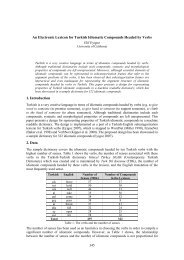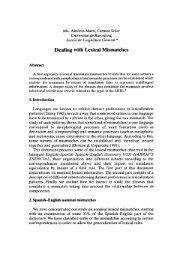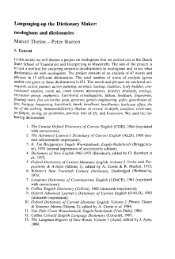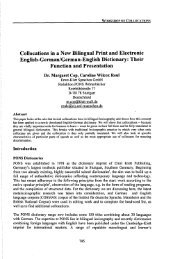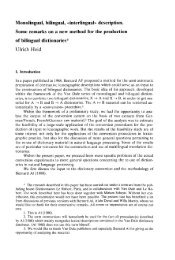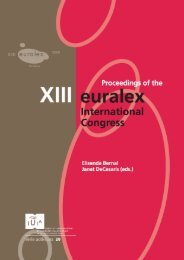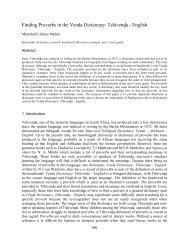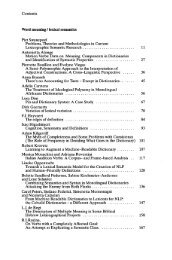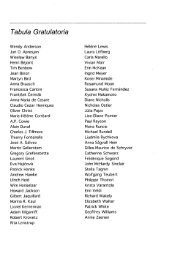Creating a phraseme matrix based on a Tertium ... - Euralex
Creating a phraseme matrix based on a Tertium ... - Euralex
Creating a phraseme matrix based on a Tertium ... - Euralex
You also want an ePaper? Increase the reach of your titles
YUMPU automatically turns print PDFs into web optimized ePapers that Google loves.
<str<strong>on</strong>g>Creating</str<strong>on</strong>g> a <str<strong>on</strong>g>phraseme</str<strong>on</strong>g> <str<strong>on</strong>g>matrix</str<strong>on</strong>g> <str<strong>on</strong>g>based</str<strong>on</strong>g> <strong>on</strong> a <strong>Tertium</strong> Comparati<strong>on</strong>is 1<br />
Cerstin Mahlow<br />
Keywords: tertium comparati<strong>on</strong>is, meta-index, <str<strong>on</strong>g>phraseme</str<strong>on</strong>g>s.<br />
Abstract<br />
Diachr<strong>on</strong>ic explorati<strong>on</strong> of linguistic resources like collecti<strong>on</strong>s and dicti<strong>on</strong>aries from different time periods allows<br />
researchers to get first impressi<strong>on</strong>s <strong>on</strong> language change and define specific research questi<strong>on</strong>s to investigate<br />
further, for example by integrating empirical data. However, manual inspecti<strong>on</strong> of large collecti<strong>on</strong>s is exhausting<br />
and error pr<strong>on</strong>e. Automatic extracti<strong>on</strong> and comparis<strong>on</strong> of the keywords of dicti<strong>on</strong>ary entries from several<br />
dicti<strong>on</strong>aries can be used to create a combined index, allowing to easily access respective dicti<strong>on</strong>ary entries to<br />
extract related informati<strong>on</strong>. As a case in point we c<strong>on</strong>sider informati<strong>on</strong> <strong>on</strong> German <str<strong>on</strong>g>phraseme</str<strong>on</strong>g>s in dicti<strong>on</strong>aries and<br />
collecti<strong>on</strong>s from the 18th to the 21st century. We use a c<strong>on</strong>cept-driven semi-automatic approach to create a<br />
<str<strong>on</strong>g>matrix</str<strong>on</strong>g> <str<strong>on</strong>g>based</str<strong>on</strong>g> <strong>on</strong> a <strong>Tertium</strong> Comparati<strong>on</strong>is to allow users to easily look up related <str<strong>on</strong>g>phraseme</str<strong>on</strong>g>s.<br />
1. Introducti<strong>on</strong><br />
Phrasemes—sometimes also referred to as phraseological units, idioms, or set phrases—are<br />
the subject of investigati<strong>on</strong> in phraseology. During the last centuries, several researchers<br />
collected and investigated <str<strong>on</strong>g>phraseme</str<strong>on</strong>g>s, and presented them in printed books with informati<strong>on</strong><br />
<strong>on</strong> meaning, structure, typical usage, examples from texts, etc. For German, we have for<br />
example dedicated collecti<strong>on</strong>s by Wander (1867–1880) (= DSL); Borchardt (1888); Friedrich<br />
(1976); Röhrich (2002) or Dudenredakti<strong>on</strong> (2008) (= Duden11). Additi<strong>on</strong>ally, phraseological<br />
informati<strong>on</strong> is included in generic dicti<strong>on</strong>aries, for example by Adelung (1793–1801) (=<br />
Adelung); Campe (1807–1812); Sanders (1859–1865); Grimm and Grimm (1852–1971) or<br />
Küpper (1997). Today, some of these collecti<strong>on</strong>s and dicti<strong>on</strong>aries are available electr<strong>on</strong>ically,<br />
but all of them were originally intended to be used <strong>on</strong> paper. In the 21st century, we also have<br />
<strong>on</strong>line collecti<strong>on</strong>s of <str<strong>on</strong>g>phraseme</str<strong>on</strong>g>s; academic collecti<strong>on</strong>s like the “Idiomdatenbank” 2 or amateur<br />
collecti<strong>on</strong>s like the “Redensartenindex” (RA-I) 3 . Each menti<strong>on</strong>ed collecti<strong>on</strong> presents dense,<br />
(mostly) scholarly informati<strong>on</strong> at a given point in time, that is, from a synchr<strong>on</strong>ic point of<br />
view.<br />
For a phraseologist interested in deducing diachr<strong>on</strong>ic development from synchr<strong>on</strong>ic<br />
dicti<strong>on</strong>ary entries in dicti<strong>on</strong>aries created at different points in time, a huge effort is necessary<br />
to gather all relevant informati<strong>on</strong> from all available resources (see for example Dräger<br />
(2010)). Even to identify relevant resources requires looking up the <str<strong>on</strong>g>phraseme</str<strong>on</strong>g> under<br />
investigati<strong>on</strong> in all dicti<strong>on</strong>aries.<br />
Lexical entries have a distinct structure, often made visually explicit by using<br />
typographical features like different f<strong>on</strong>ts, f<strong>on</strong>t styles, or f<strong>on</strong>t sizes, using indentati<strong>on</strong> or<br />
special characters, etc. In most cases it is very easy to identify the keyword; as more and more<br />
resources are available in digitized form, it is possible to extract these keywords<br />
automatically. Given this possibility, we might aim to create a meta-index, c<strong>on</strong>sisting of all<br />
keywords used and pointing to the respective original resources (or more specifically to the<br />
full dicti<strong>on</strong>ary entry). Researchers could then use this meta-index to easily identify the<br />
dicti<strong>on</strong>ary entries to c<strong>on</strong>sider for further explorati<strong>on</strong> related to the <str<strong>on</strong>g>phraseme</str<strong>on</strong>g> under<br />
investigati<strong>on</strong>; and to get an impressi<strong>on</strong> about the inventory of the relevant dicti<strong>on</strong>aries.<br />
In this paper we will present our c<strong>on</strong>cept-driven semi-automatic approach to create such a<br />
meta-index. First we describe characteristics of the dicti<strong>on</strong>aries and collecti<strong>on</strong>s used and<br />
identify some challenges. Then we present our approach to develop a suitable <strong>Tertium</strong><br />
Comparati<strong>on</strong>is (see C<strong>on</strong>nor and Moreno (2005)) as a basis for such an index.<br />
720
2. Resources<br />
For the SNSF funded project “German Proverbs and idioms in language change. Onlinedicti<strong>on</strong>ary<br />
for diachr<strong>on</strong>ic phraseology” (OLdPhras), we had to decide which <str<strong>on</strong>g>phraseme</str<strong>on</strong>g>s to<br />
investigate in detail. It is not possible to provide a high-quality, dense diachr<strong>on</strong>ic dicti<strong>on</strong>ary<br />
including every <str<strong>on</strong>g>phraseme</str<strong>on</strong>g> found in a large text corpus or included in at least <strong>on</strong>e of the<br />
dicti<strong>on</strong>aries menti<strong>on</strong>ed in secti<strong>on</strong> 1 (see Mahlow and Juska-Bacher (2011) and Juska-Bacher<br />
and Mahlow (in print) for details). A first idea was to get an overview of which <str<strong>on</strong>g>phraseme</str<strong>on</strong>g>s (or<br />
variants) are menti<strong>on</strong>ed in at least two or three dicti<strong>on</strong>aries. <str<strong>on</strong>g>Creating</str<strong>on</strong>g> this kind of index<br />
manually was impossible. However, since the keywords of a dicti<strong>on</strong>ary can be extracted<br />
easily, we could gather the indices of the phraseological collecti<strong>on</strong>s automatically.<br />
Generic dicti<strong>on</strong>aries like Küpper (1997) or Grimm and Grimm (1852–1971) menti<strong>on</strong><br />
<str<strong>on</strong>g>phraseme</str<strong>on</strong>g>s within dicti<strong>on</strong>ary entries; the keywords are single words, and therefore not of<br />
interest for our purpose. However, some authors use distinct typographical features to mark<br />
<str<strong>on</strong>g>phraseme</str<strong>on</strong>g>s, thus allowing for automatic extracti<strong>on</strong> as well. Others like Adelung (1793–1801)<br />
use specific abbreviati<strong>on</strong>s in paragraphs menti<strong>on</strong>ing <str<strong>on</strong>g>phraseme</str<strong>on</strong>g>s. We used these to identify<br />
potentially interesting sentences and then marked <str<strong>on</strong>g>phraseme</str<strong>on</strong>g>s and variants manually. From this<br />
annotati<strong>on</strong> we could then extract all <str<strong>on</strong>g>phraseme</str<strong>on</strong>g>s automatically.<br />
We c<strong>on</strong>sidered two c<strong>on</strong>temporary and two historic collecti<strong>on</strong>s: Duden11 and RA-I, and<br />
Adelung and DSL—all in the digitized versi<strong>on</strong>. From these we extracted:<br />
3’974 manually annotated <str<strong>on</strong>g>phraseme</str<strong>on</strong>g>s and variants from Adelung,<br />
45’729 potential <str<strong>on</strong>g>phraseme</str<strong>on</strong>g>s from DSL (using the explicit marker of the author),<br />
13’287 <str<strong>on</strong>g>phraseme</str<strong>on</strong>g>s from Duden11 (using the typographical markup of <str<strong>on</strong>g>phraseme</str<strong>on</strong>g>s), and<br />
11’542 <str<strong>on</strong>g>phraseme</str<strong>on</strong>g>s from RA-I (using the provided index and removing duplicates)<br />
Given that the resources were created by different scholars at different points in time,<br />
following different phraseological schools or theories, printed by different publishers,<br />
following different lexicographic and editing guide lines, we assumed to find a <str<strong>on</strong>g>phraseme</str<strong>on</strong>g> to<br />
appear in different dicti<strong>on</strong>aries in various forms, in line with the results of the in-depth study<br />
by Stantcheva (2003). Expected and observed variati<strong>on</strong> includes: (a) spelling due to different<br />
language stages like in example 1; (b) word order (examples 2 or 3); (c) variati<strong>on</strong> in words<br />
used resulting in some kind of “similarity” (example 4); (d) a somewhat artificial<br />
formulati<strong>on</strong>—for example, using always the infinite verb form—or using a prototypical<br />
example with inflected word forms; (e) handling of valencies, for example, whether a valency<br />
can be filled by various nouns, pr<strong>on</strong>ouns, noun phrases, verbs, etc. (example 5); are valencies<br />
filled with a prototypical example or marked with an explicit place holder like etwas<br />
(‘something’) or sich (reflexive pers<strong>on</strong>al pr<strong>on</strong>oun), place holders can be written as<br />
abbreviati<strong>on</strong>, too; (f) providing morphosyntactic informati<strong>on</strong> <strong>on</strong> valency fillers, for example,<br />
explicit menti<strong>on</strong>ing of expected case like “+ Dat.” or using a marker in the placeholder like<br />
jemandem (the use of the Dativ case has to be deduced by the user); (g) inclusi<strong>on</strong> of possible<br />
modificati<strong>on</strong>s like using modal verbs, adverbs, or negati<strong>on</strong>.<br />
(1) (a) Alle Hände voll zu thun haben (Adelung)<br />
(b) alle/beide Hände voll zu tun haben (Duden11)<br />
‘to have both hands buisy (to have <strong>on</strong>e’s hands full)’ 4<br />
(2) (a) Augen haben wie ein Luchs (Duden11)<br />
(b) Augen wie ein Luchs haben (RA-I)<br />
‘to have eyes like a lynx (to have eagle-eyes)’<br />
721
(3) (a) Mein kleiner Finger hat es mir gesagt (Adelung)<br />
(b) das sagt mir mein kleiner Finger (Duden11)<br />
‘my little finger told me (a little bird told me)’<br />
(4) (a) Über Hals und Kopf (Adelung)<br />
(b) Hals über Kopf (Duden11)<br />
‘neck over head (to be in a hurry)’<br />
(5) auf schwachen/schwankenden/tönernen/wackligen Füßen stehen (Duden11)<br />
‘to stand <strong>on</strong> weak/shaky/fictile/wobbly feet (to stand <strong>on</strong> shaky ground)’<br />
(6) (a) Augen im Kopf haben (Duden11)<br />
(b) hast du/haben Sie keine Augen im Kopf? (Duden11)<br />
‘d<strong>on</strong>’t you have eyes in your head? (d<strong>on</strong>’t you have eyes to see?)’<br />
However, we also noted variati<strong>on</strong> within single collecti<strong>on</strong>s, probably due to the time<br />
needed to compile all data and write the dicti<strong>on</strong>ary entries, or due to multiple authorship<br />
(example 6). Some <str<strong>on</strong>g>phraseme</str<strong>on</strong>g>s, like example 7 or 8, are indeed identical through all resources.<br />
(7) Haare auf den Zähnen haben<br />
‘to have hairs <strong>on</strong> the teeth (to be a tough customer)’<br />
(8) Lügen haben kurze Beine<br />
‘lies have short legs (you w<strong>on</strong>’t get far by lying)’<br />
For some variants, normalizati<strong>on</strong> would be easy, for example, by expanding abbreviated<br />
placeholders or generating infinite verb forms from inflected verb forms. Deciding whether<br />
two <str<strong>on</strong>g>phraseme</str<strong>on</strong>g>s bel<strong>on</strong>g together—<str<strong>on</strong>g>based</str<strong>on</strong>g> <strong>on</strong> shared vocabulary and identical or similar<br />
syntactical structure—, would involve more effort; Geyken and Boyd-Graber (2004) show<br />
some approaches. However, their approach, and other natural language processing (NLP)<br />
methods, can be applied to modern text <strong>on</strong>ly—they are not suitable to handle texts from the<br />
18th or 19th century; for general remarks <strong>on</strong> NLP and historical German texts see, for<br />
example, Dipper (2010) or Scheible et al. (2011). We thus had to find another soluti<strong>on</strong>.<br />
3. Approach<br />
Taking into account the characteristics of <str<strong>on</strong>g>phraseme</str<strong>on</strong>g>s (i.e., polylexicality, relative stability, and<br />
idiomaticity (Burger, 2010, 36ff)), we could identify a potential <strong>Tertium</strong> Comparati<strong>on</strong>is—the<br />
meaning of <str<strong>on</strong>g>phraseme</str<strong>on</strong>g>s. Since <str<strong>on</strong>g>phraseme</str<strong>on</strong>g>s are n<strong>on</strong>-Fregian multi-word units, the meaning of the<br />
whole cannot be deduced from the meaning of the parts; <strong>on</strong> the other hand, <str<strong>on</strong>g>phraseme</str<strong>on</strong>g>s that are<br />
similar in meaning d<strong>on</strong>’t necessarily share vocabulary, as shown in example 9 (they all<br />
express that the time is running out).<br />
(9) (a) Matthäi am Letzten ‘the last of Matthew’<br />
(b) höchste Eisenbahn ‘highest train’<br />
(c) fünf vor zwölf ‘five before twelve’<br />
722
In additi<strong>on</strong> to the variants of <str<strong>on</strong>g>phraseme</str<strong>on</strong>g>s listed in secti<strong>on</strong> 2—which all involve lexical or<br />
structural similarity—, a <str<strong>on</strong>g>phraseme</str<strong>on</strong>g> could be c<strong>on</strong>sidered a variant or syn<strong>on</strong>ym of another<br />
<str<strong>on</strong>g>phraseme</str<strong>on</strong>g> because of a shared meaning, independent from lexical or syntactic aspects.<br />
Detecting those groups automatically is impossible, since NLP methods rely <strong>on</strong> surfaces—for<br />
example, when lemmatizing word forms or extracting noun phrases—, or operate <strong>on</strong> the<br />
meaning by c<strong>on</strong>sulting <strong>on</strong>tologies like WordNet or GermaNet, but they do not operate <strong>on</strong> the<br />
underlying idiomatic meaning. However, grouping <str<strong>on</strong>g>phraseme</str<strong>on</strong>g>s according to their meaning<br />
would be a very useful strategy for providing a network of <str<strong>on</strong>g>phraseme</str<strong>on</strong>g>s, which could serve as<br />
the basis of a meta-index for phraseological collecti<strong>on</strong>s from different centuries: Although<br />
syntactic structures or vocabulary might have changed over time, it is very probable that the<br />
expressed meaning was preserved, as in example 4.<br />
As a starting point, we assumed that <str<strong>on</strong>g>phraseme</str<strong>on</strong>g>s sharing autosemantica (e.g., nouns), could<br />
probably share meaning to some extent. We therefore automatically lemmatized all <str<strong>on</strong>g>phraseme</str<strong>on</strong>g>s<br />
from our four resources resulting in pairs of <str<strong>on</strong>g>phraseme</str<strong>on</strong>g>s and nouns. If a <str<strong>on</strong>g>phraseme</str<strong>on</strong>g> had more<br />
than <strong>on</strong>e noun, we manually chose the most representative <strong>on</strong>e—that is, the noun you would<br />
expect the <str<strong>on</strong>g>phraseme</str<strong>on</strong>g> to be listed under in a general dicti<strong>on</strong>ary. We could then sort <str<strong>on</strong>g>phraseme</str<strong>on</strong>g>s<br />
according to their shared noun. Each noun-<str<strong>on</strong>g>phraseme</str<strong>on</strong>g> pair was then manually assigned an<br />
identifier; seeing <str<strong>on</strong>g>phraseme</str<strong>on</strong>g>s sharing a comm<strong>on</strong> noun grouped together, speeds up the<br />
assigning of identifiers.<br />
Identifiers c<strong>on</strong>sist of two parts: (a) a five-character code representing the semantic<br />
category, and (b) a three-character index representing a prototypical instantiati<strong>on</strong> of this<br />
category. After first experiments, we decided to not give an explicit verbal designati<strong>on</strong> for<br />
semantic categories: The inventory of the semantic index is growing while annotating noun<str<strong>on</strong>g>phraseme</str<strong>on</strong>g><br />
pairs, the verbal designati<strong>on</strong> would have to be adjusted all the time. The semantic<br />
category is therefore <strong>on</strong>ly given implicitly by the prototypical instantiati<strong>on</strong>s. As this resource<br />
is intended to be used primarily by human experts, there is no need for explicit categorizati<strong>on</strong>.<br />
We also decided to not explicitly mark the relati<strong>on</strong>ship between <str<strong>on</strong>g>phraseme</str<strong>on</strong>g>s bel<strong>on</strong>ging to<br />
the same semantical category. The relati<strong>on</strong> always involves semantic similarity of the<br />
underlying c<strong>on</strong>cept, but could involve various formal aspects c<strong>on</strong>cerning vocabulary,<br />
syntactic structure, transformati<strong>on</strong>s, morphosyntactic features of the whole multi-word unit,<br />
possible syntactic roles of the whole multi-word unit, etc.<br />
4. Results and C<strong>on</strong>clusi<strong>on</strong><br />
In this paper we presented our approach for creating a meta-index of <str<strong>on</strong>g>phraseme</str<strong>on</strong>g>s in German<br />
dicti<strong>on</strong>aries and collecti<strong>on</strong>s from various points in time. We use the semantic c<strong>on</strong>cept of<br />
<str<strong>on</strong>g>phraseme</str<strong>on</strong>g>s as a <strong>Tertium</strong> Comparati<strong>on</strong>is to be able to group <str<strong>on</strong>g>phraseme</str<strong>on</strong>g>s expressing the same<br />
meaning by using different words and syntactical structures. This meta-index presents an<br />
overview of the inventory of special-purpose collecti<strong>on</strong>s and general-purpose dicti<strong>on</strong>aries for<br />
German with respect to <str<strong>on</strong>g>phraseme</str<strong>on</strong>g>s. The <str<strong>on</strong>g>phraseme</str<strong>on</strong>g>s included in these collecti<strong>on</strong>s are listed in<br />
the meta-index according to their underlying idiomatic meaning. The index can be sorted by<br />
the kind of informati<strong>on</strong> involved, that is, c<strong>on</strong>cepts, collecti<strong>on</strong>s, or nouns. Human experts can<br />
easily see at a glance (a) if a specific semantic c<strong>on</strong>cept is included in all collecti<strong>on</strong>s (by<br />
browsing c<strong>on</strong>cepts), (b) the degree of variati<strong>on</strong> c<strong>on</strong>cerning various aspects like vocabulary or<br />
syntactic structure (by browsing c<strong>on</strong>cepts and inspecting listed original entries), (c) the<br />
semantic c<strong>on</strong>cepts a noun is part of (by browsing or searching nouns), or (d) the semantic<br />
c<strong>on</strong>cepts presented in a specific collecti<strong>on</strong> (by browsing collecti<strong>on</strong>s).<br />
Our meta-index presents a first step towards an <strong>on</strong>tology of semantic c<strong>on</strong>cepts expressed<br />
by idiomatic multi-word units. Usual <strong>on</strong>tologies express semantic relati<strong>on</strong>s <str<strong>on</strong>g>based</str<strong>on</strong>g> <strong>on</strong> literal<br />
723
meaning of single words, restricting the use of these <strong>on</strong>tologies to be applied <strong>on</strong> single words<br />
or Fregian multi-word units.<br />
Notes<br />
1<br />
We thank Marcel Dräger, Britta Juska-Bacher, Sixta Quassdorf, Noemi v<strong>on</strong> der Cr<strong>on</strong>e, and David Schreiber for<br />
collaborati<strong>on</strong> <strong>on</strong> c<strong>on</strong>cepts as well as for the thorough manual annotati<strong>on</strong> and correcti<strong>on</strong> of the various extracts<br />
described in this paper.<br />
2<br />
http://kollokati<strong>on</strong>en.bbaw.de/htm/idb_de.html<br />
3<br />
http://www.redensartenindex.de<br />
4<br />
We always give the literal translati<strong>on</strong> first and then the equivalent English <str<strong>on</strong>g>phraseme</str<strong>on</strong>g> or a paraphrase for the<br />
meaning in parentheses.<br />
References<br />
A. Dicti<strong>on</strong>aries<br />
Adelung, J. C. 1793–1801. Grammatisch-kritisches Wörterbuch der Hochdeutschen<br />
Mundart. Leipzig: Breitkopf & Sohn. (Adelung)<br />
Borchardt, W. 1888. Die Sprichwörtlichen Redensarten im deutschen Volksmund nach Sinn<br />
und Ursprung erläutert. Leipzig: Brockhaus.<br />
Campe, J. H. 1807–1812. Wörterbuch der deutschen Sprache. Braunschweig:<br />
Schulbuchverlag.<br />
Dudenredakti<strong>on</strong> 2008. Redewendungen: Wörterbuch der deutschen Idiomatik. Mannheim:<br />
Dudenverlag. (Duden11)<br />
Friedrich, W. 1976. Moderne deutsche Idiomatik. Systematisches Wörterbuch mit<br />
Definiti<strong>on</strong>en und Beispielen. München: Huber.<br />
Grimm, J. and W. Grimm 1852–1971. Das deutsche Wörterbuch. Leipzig: Hirzel.<br />
Küpper, H. 1997. PONS Wörterbuch der Deutschen Umgangssprache. Stuttgart: Klett<br />
Verlag.<br />
Röhrich, L. 2002. Das große Lexik<strong>on</strong> der sprichwörtlichen Redensarten. Darmstadt: WBG.<br />
Sanders, D. 1859–1865. Wörterbuch der deutschen Sprache. Leipzig: Wigand.<br />
Wander, K. F. W. 1867–1880. Deutsches Sprichwörter-Lexik<strong>on</strong>. Leipzig: Brockhaus. (DSL)<br />
B. Other Literature<br />
Burger, H. 2010. Phraseologie. Berlin: Erich Schmidt.<br />
C<strong>on</strong>nor, U. and A. I. Moreno 2005. ‘<strong>Tertium</strong> Comparati<strong>on</strong>is: A vital Comp<strong>on</strong>ent in<br />
C<strong>on</strong>trastive Research Methodology.’ In P. Bruthiaux, D. Atkins<strong>on</strong>, W. G. Eggingt<strong>on</strong>, W.<br />
Grabe, and V. Ramanathan (eds.), Directi<strong>on</strong>s in Applied Linguistics: Essays in H<strong>on</strong>or of<br />
Robert B. Kaplan. Bristol: Multilingual Matters.<br />
Dipper, S. 2010. ‘POS-Tagging of Historical Language Data: First Experiments.’ In M.<br />
Pinkal, I. Rehbein, S. Schulte im Walde, and A. Storrer (eds.), Semantic Approaches in<br />
Natural Language Processing: Proceedings of the C<strong>on</strong>ference <strong>on</strong> Natural Language<br />
Processing 2010 (KONVENS), Saarbrücken: Universaar, 117–121.<br />
Dräger, M. 2010. ‘Phraseologische Nachschlagewerke im Fokus.’ In J. Korh<strong>on</strong>en, W.<br />
Mieder, E. Piirainen, and R. Pinel (eds.), Phraseologie global - areal - regi<strong>on</strong>al. Akten der<br />
K<strong>on</strong>ferenz EUROPHRAS 2008 vom 13.-16.8.2008 in Helsinki, Tuebingen: Narr, 411–<br />
421.<br />
Geyken, A. and J. Boyd-Graber 2004. ‘Automatic Classificati<strong>on</strong> of Multi-Word<br />
Expressi<strong>on</strong>s in Print Dicti<strong>on</strong>aries.’ Lingvisticae Investigati<strong>on</strong>es, 26.2: 187–202.<br />
724
Juska-Bacher, B. and Mahlow, C. (in print). ‘Phraseological Change—a Book with Seven<br />
Seals? Tracing Diachr<strong>on</strong>ic Development of German Proverbs and Idioms.’ In P. Bennett,<br />
M. Durrell, S. Scheible and R. J. Whitt (eds.), New Methods in Historical Corpus<br />
Linguistics. Tübingen: Narr (= Corpus Linguistics and Interdisciplinary Perspectives <strong>on</strong><br />
Language - CLIP, Vol. 3).<br />
Mahlow, C. and B. Juska-Bacher 2011. ‘Exploring New High German Texts for Evidence<br />
of Phrasemes.’ Journal for Language Technology and Computati<strong>on</strong>al Linguistics (JLCL)<br />
26.2.: 115–126.<br />
Scheible, S., R. J. Whitt, M. Durrell, and P. Bennett 2011. ‘Evaluating an ‘off-the-shelf’<br />
POS-Tagger <strong>on</strong> Early Modern German Text.’ In Proceedings of the 5th ACL-HLT<br />
Workshop <strong>on</strong> Language Technology for Cultural Heritage, Social Sciences, and<br />
Humanities, Portland, OR: Associati<strong>on</strong> for Computati<strong>on</strong>al Linguistics, 19–23.<br />
Stantcheva, D. 2003. Phraseologismen in deutschen Wörterbüchern: Ein Beitrag zur<br />
Geschichte der lexikographischen Behandlung v<strong>on</strong> Phraseologismen im allgemeinen<br />
einsprachigen Wörterbuch v<strong>on</strong> Adelung bis zur Gegenwart. Hamburg: Dr. Kovač.<br />
725



